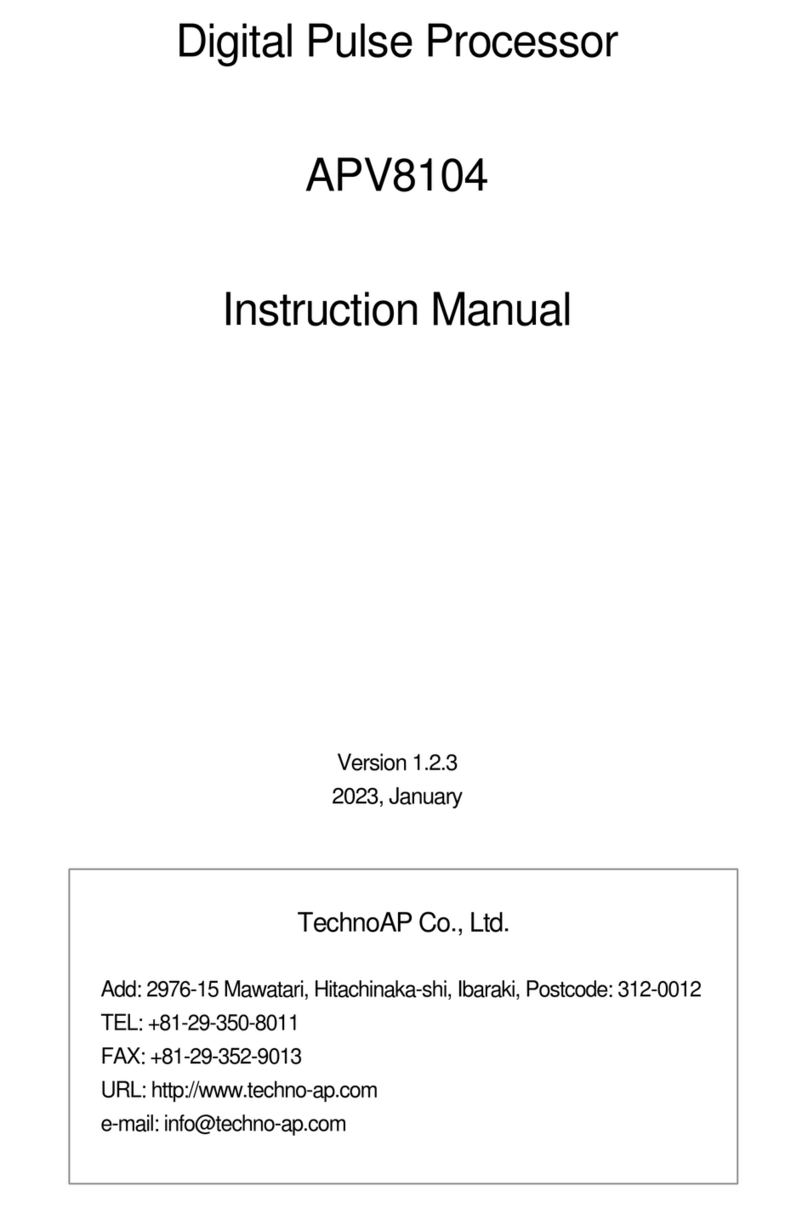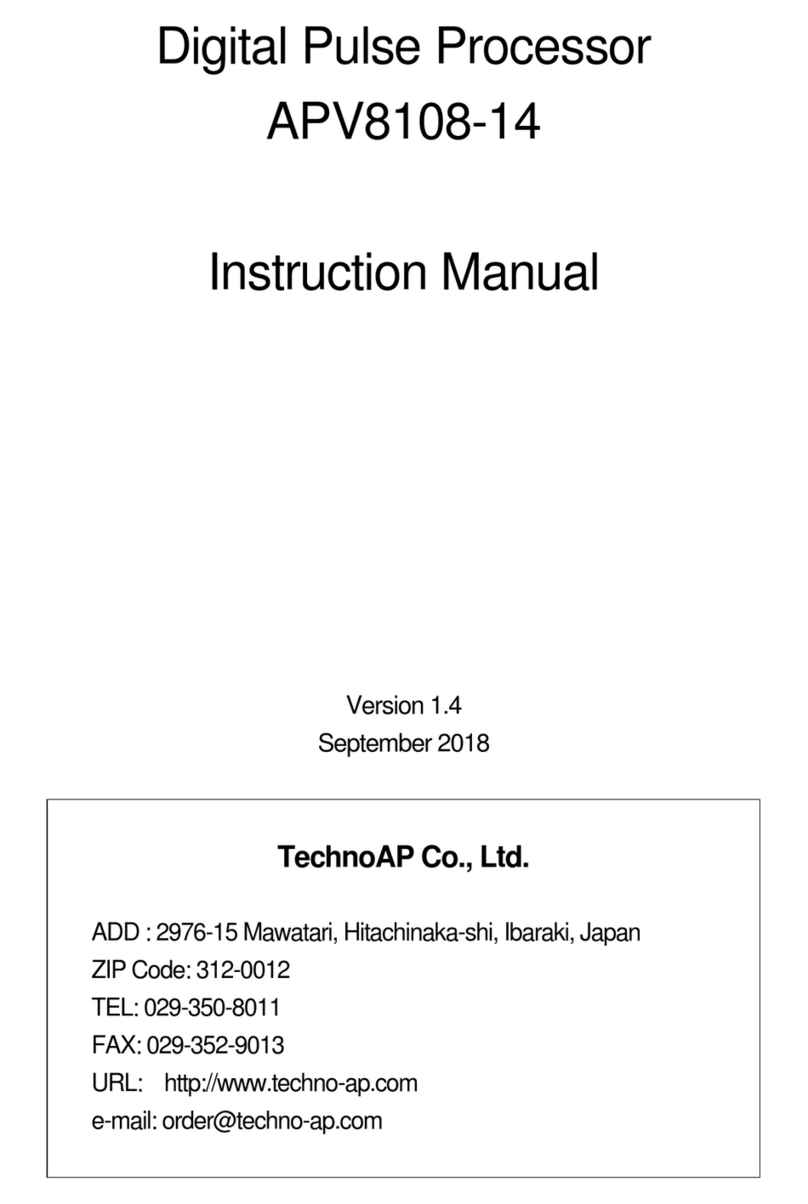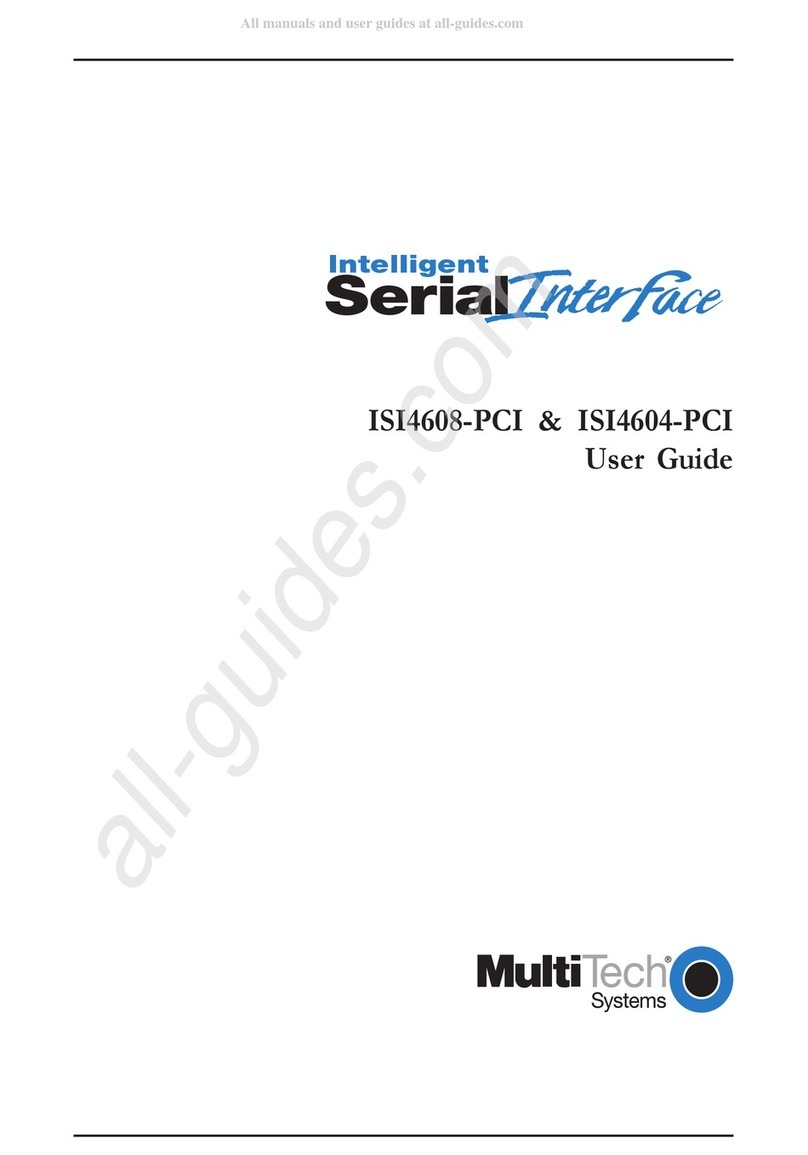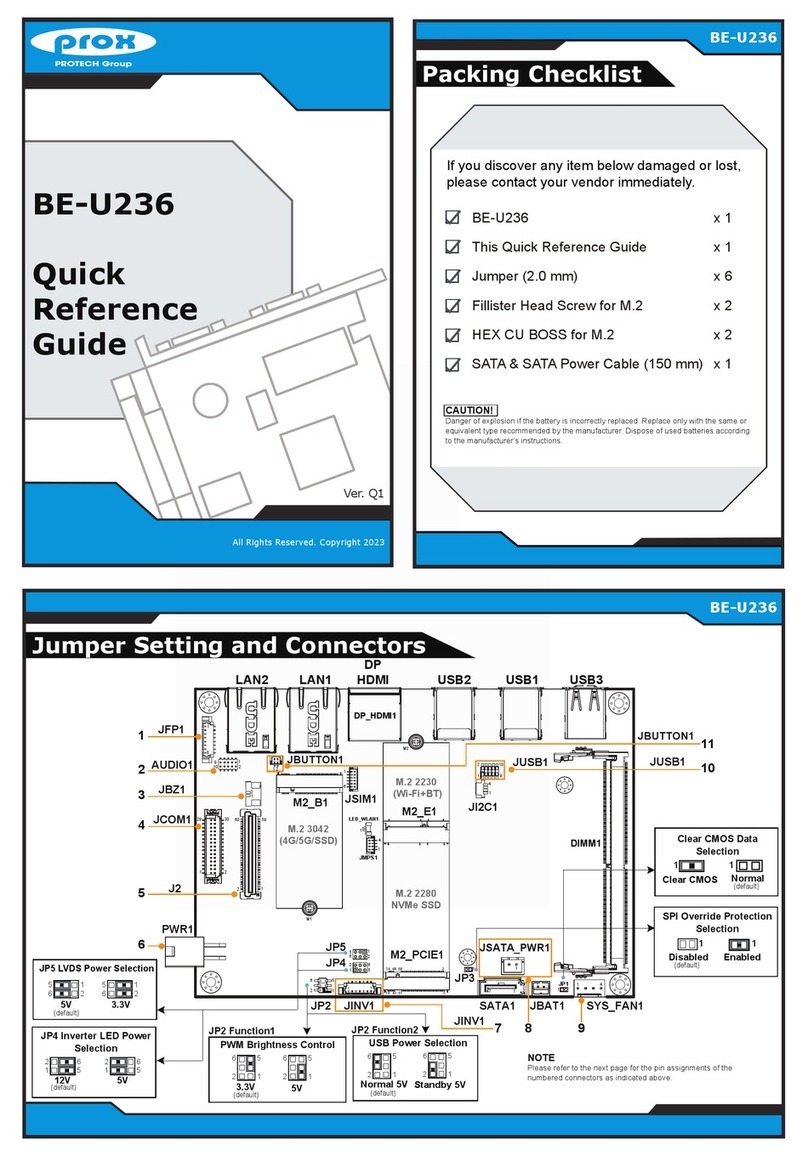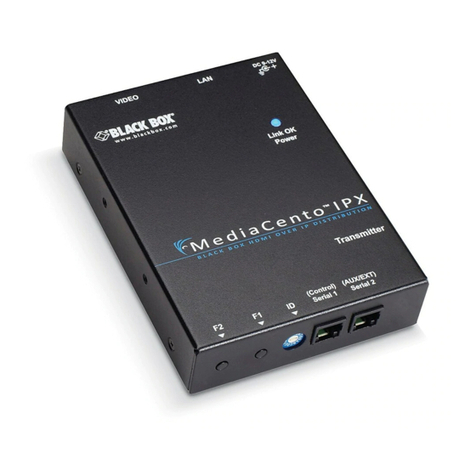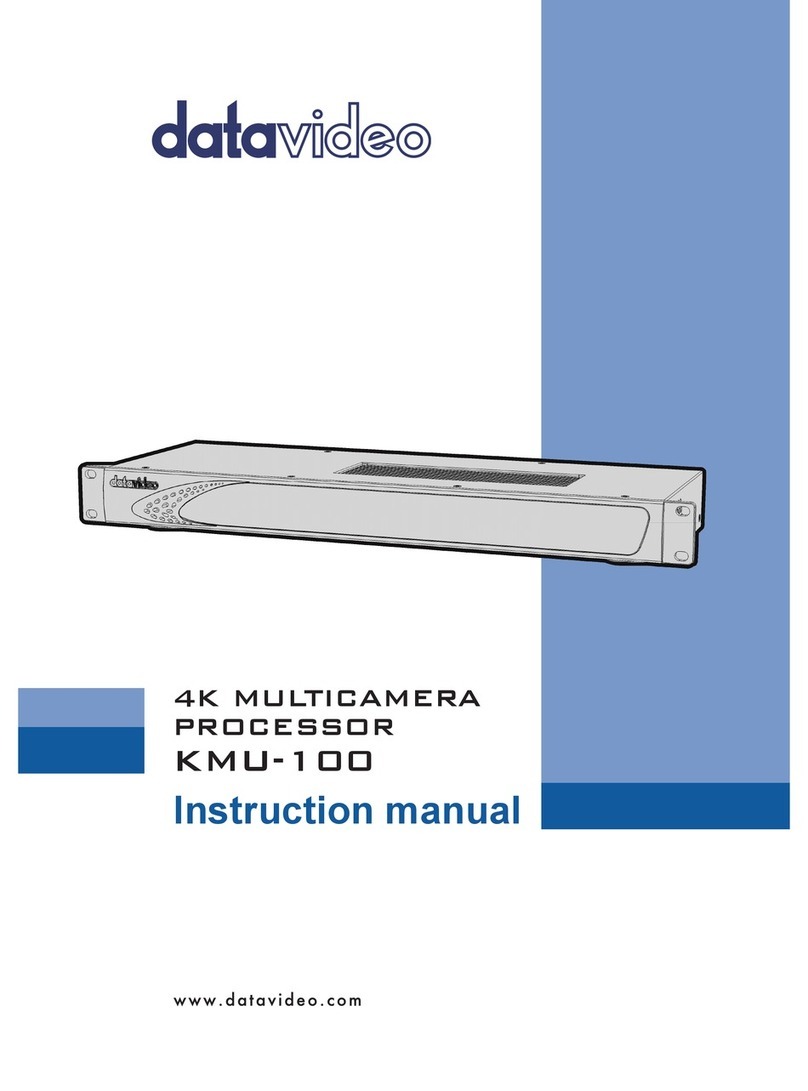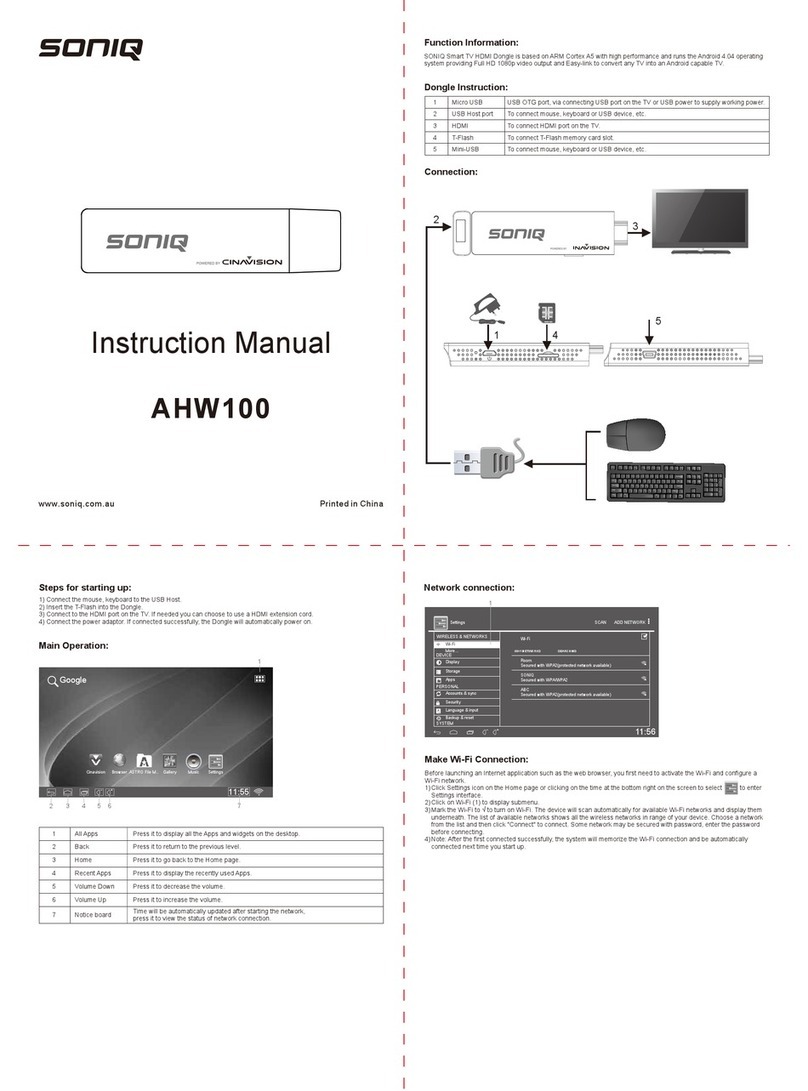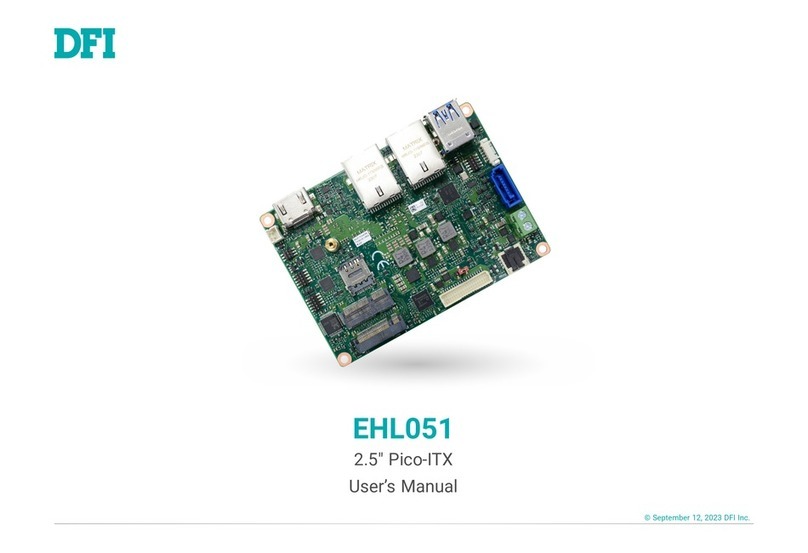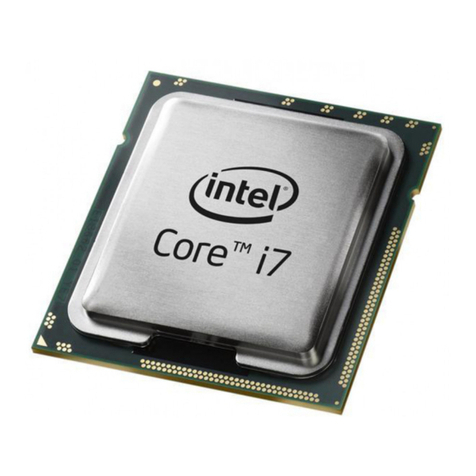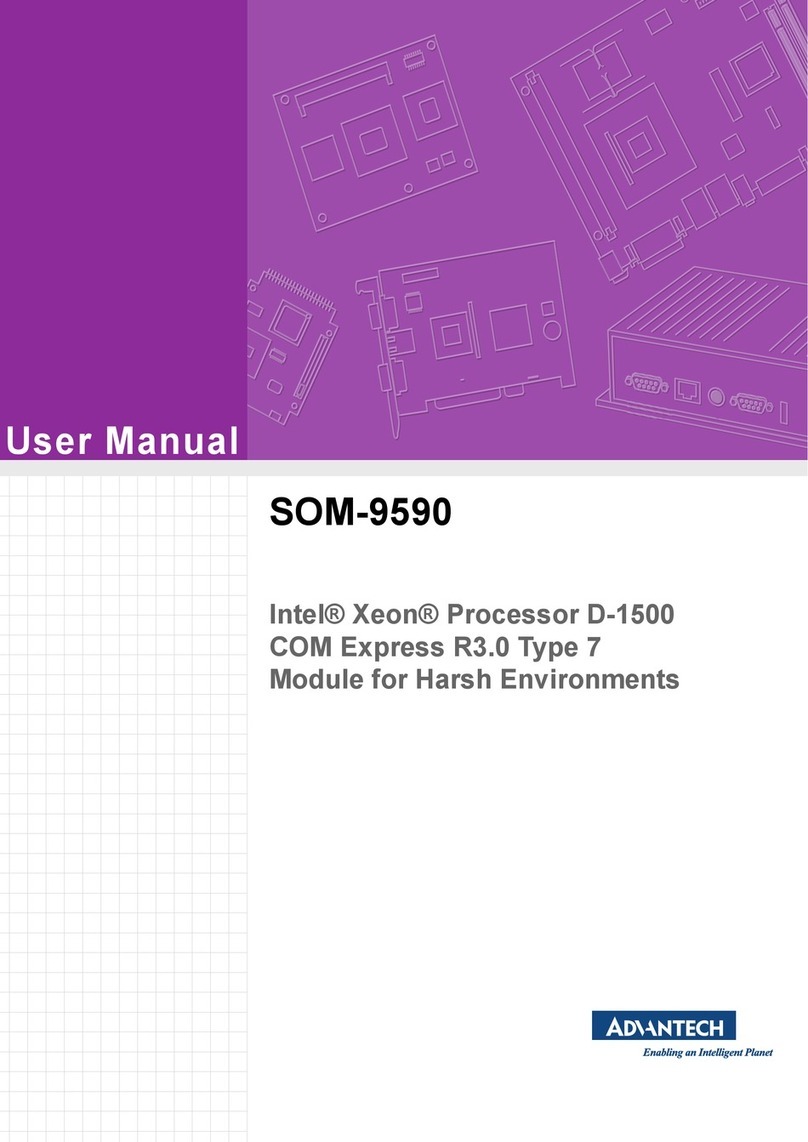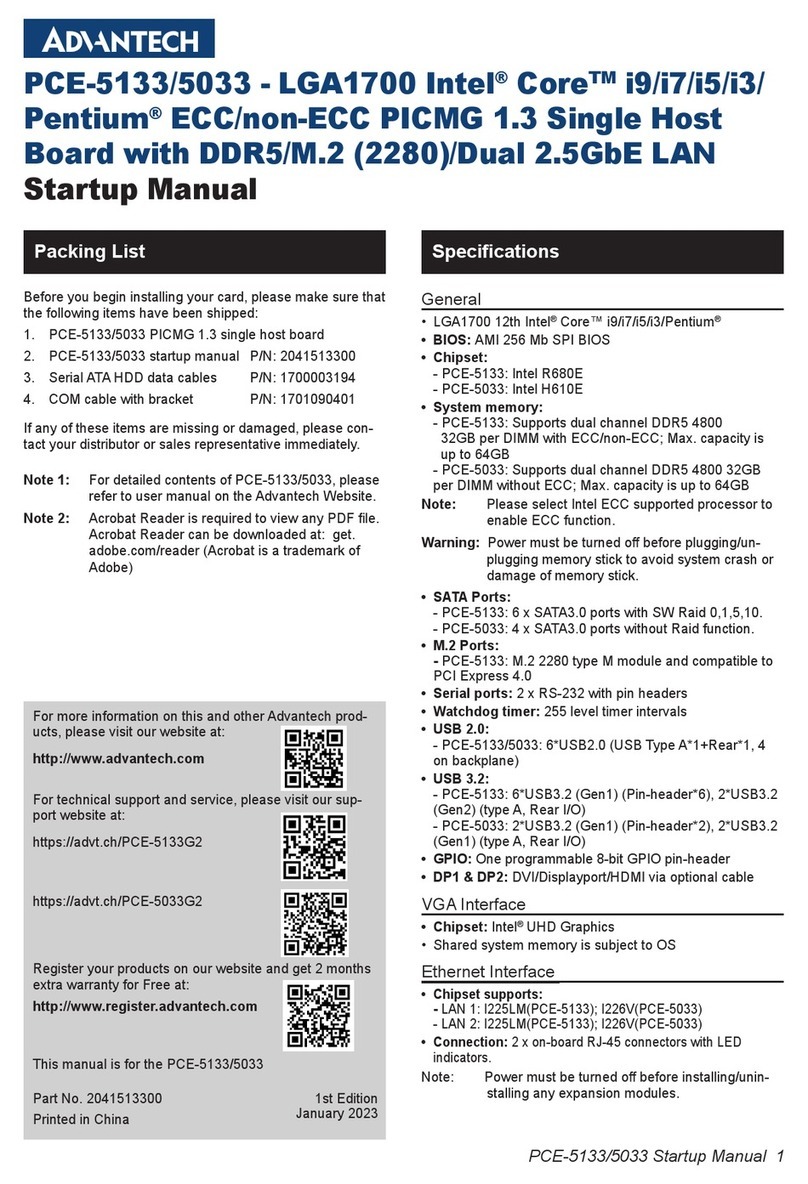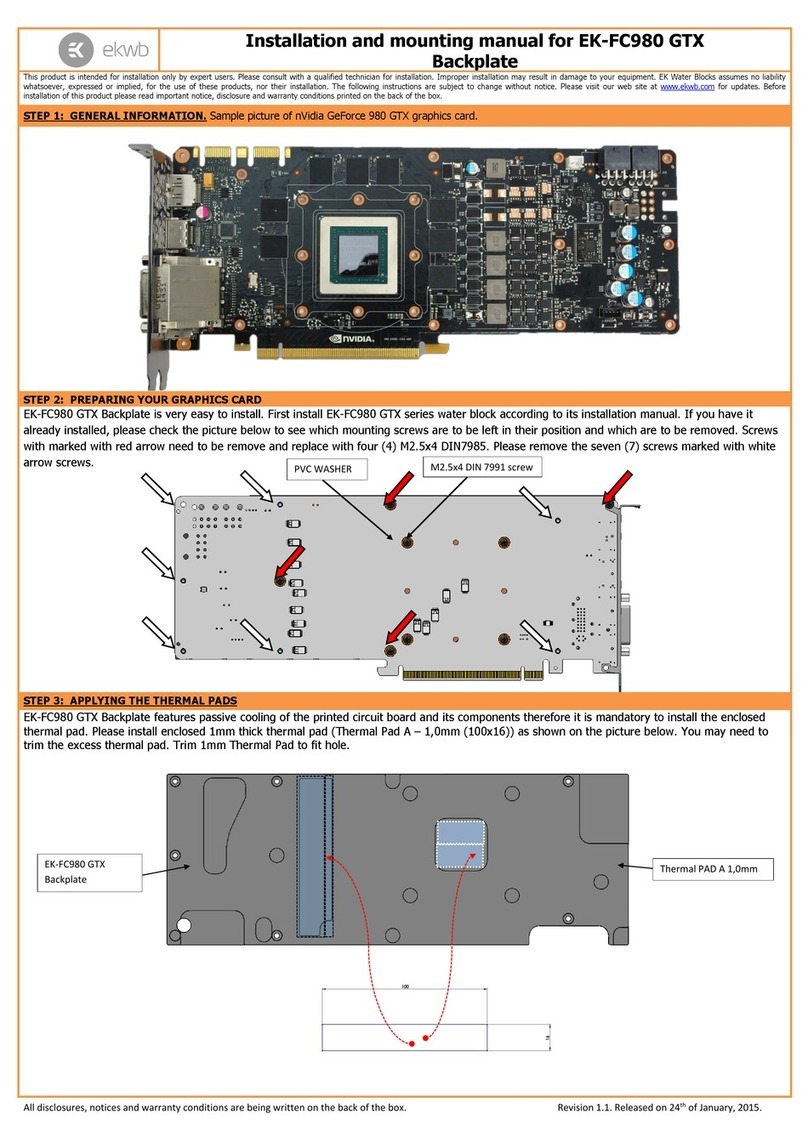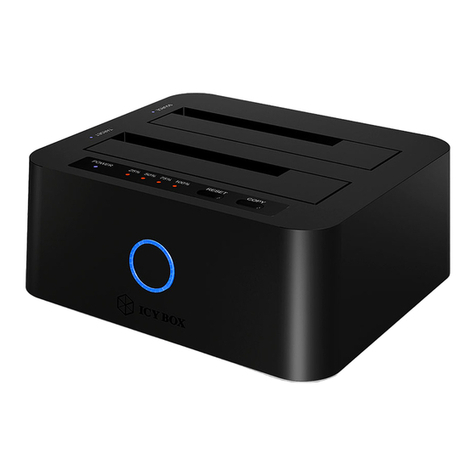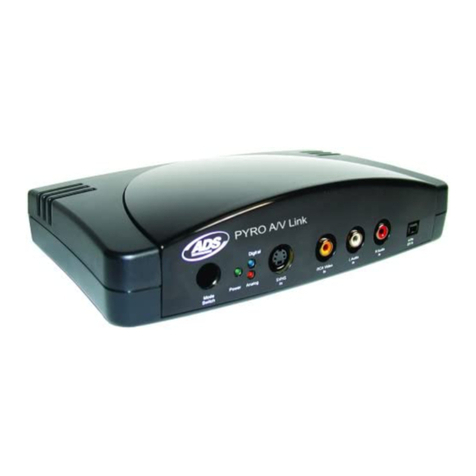TechnoAP APV82516 User manual

Digital Pulse Processor
APV82516
Instruction Manual
Version 1.0.0
2022, December
TechnoAP Co., Ltd.
Add: 2976-15 Mawatari, Hitachinaka-shi, Ibaraki, Postcode: 312-0012
TEL: +81-29-350-8011
FAX: +81-29-352-9013
URL: http://www.techno-ap.com
e-mail: info@techno-ap.com

APV2516 Instruction Manual
2
TechnoAP Co., Ltd.
Safety Precautions / Disclaimer
Thank you very much for purchasing the digitizer APV82516 (hereinafter "This board") of TechnoAP Co.,
Ltd. (hereinafter "We"). Please read this "Safety Precautions / Disclaimer" before using this device, be sure to
observe the contents, and use it correctly.
We are not responsible for any damage caused by abnormality of device, detector, connected device,
application, damage to failure, other secondary damage, even if accident caused by using this device.
Prohibited matter
This device cannot be used for applications requiring special quality and reliability
related to human life, accident.
This device cannot be used in places with high temperature, high humidity and high
vibration.
Do not apply a power supply that exceeds the rating.
Do not turn the power on while other metals are in contact with the board surface.
Note
If there is smoking or abnormal heat generation in this device, turn off the power
immediately.
This board may not work properly in noisy environments.
Be careful with static electricity.
The specifications of this board and the contents of the related documents are subject
to change without notice.
Warranty policy
The warranty conditions of "our product" are as follows.
Warranty period One year from date of purchase.
Guarantee contents Repair or replacement will be carried out in case of breakdown even though you
have used correctly according to this instruction manual within the warranty period
Out of warranty
We do not warranty if the cause of the failure falls under any of the following.
1. Failure or damage due to misuse or improper repair or modification or
disassembly.
2. Failure and damage due to falling etc.
3. Breakdown / damage in harsh environments (high temperature / high humidity,
under zero, condensation etc.).
4. Causes other than the above, other than "our products".
5. Consumables.

APV2516 Instruction Manual
3
TechnoAP Co., Ltd.
- Content -
Safety Precautions / Disclaimer ...............................................................................................................................................................................2
1. Overview.....................................................................................................................................................................................................................5
1.1. Overview ........................................................................................................................................................................................................5
1.2. Features ..........................................................................................................................................................................................................6
2. Specifications ........................................................................................................................................................................................................7
3. Appearance ............................................................................................................................................................................................................8
4. Setup ..............................................................................................................................................................................................................................9
4.1. Installation of application ............................................................................................................................................................9
4.2. Connection ..................................................................................................................................................................................................9
4.3. Setup of the network ................................................................................................................................................................ 10
5. Application window ................................................................................................................................................................................. 11
5.1. Startup window ............................................................................................................................................................................... 11
5.2. config tab ................................................................................................................................................................................................. 13
5.2.1. list-pile ups * Option ................................................................................................................................................................. 21
5.2.2. pile-up reject * Option ............................................................................................................................................................ 21
5.2.3. OR output * Optiong ............................................................................................................................................................... 22
5.3. file tab ........................................................................................................................................................................................................... 23
5.4. wave tab ................................................................................................................................................................................................... 25
5.5. spectrum tab ....................................................................................................................................................................................... 27
6. Measurement ................................................................................................................................................................................................... 29
6.1. Histogram mode .............................................................................................................................................................................. 29
6.1.1. Environment .................................................................................................................................................................................. 29
6.1.2. Power supply and connection ........................................................................................................................................ 29
6.1.3. Application startup and configuratiom ...................................................................................................................... 29
6.1.4. Waveforme confirmation .................................................................................................................................................... 30
6.1.5. Measurement start ................................................................................................................................................................... 32
6.1.6. End of measurement ............................................................................................................................................................. 32
6.2. List mode .................................................................................................................................................................................................. 33
6.2.1. Preapration ..................................................................................................................................................................................... 33
6.2.2. Confirmation of energy spectrum ................................................................................................................................ 33
6.2.3. Setting ................................................................................................................................................................................................ 34
6.2.4. Measurement start ................................................................................................................................................................... 34
6.2.5. End of measurement ............................................................................................................................................................. 34
7. Quit ............................................................................................................................................................................................................................... 35
8. File .................................................................................................................................................................................................................................. 36
8.1. Histogram data file ........................................................................................................................................................................ 36
8.2. List data file ............................................................................................................................................................................................ 38
8.3. List-wave and list pile-up wave data file * Option ................................................................................. 39

APV2516 Instruction Manual
4
TechnoAP Co., Ltd.
9. Troubleshooting ........................................................................................................................................................................................... 40
9.1. Connection error occurs ....................................................................................................................................................... 40
9.2. Command error occurs .......................................................................................................................................................... 40
9.3. Histogram is not displayed ................................................................................................................................................... 41
9.4. Change IP address ....................................................................................................................................................................... 41

APV2516 Instruction Manual
5
TechnoAP Co., Ltd.
1.Overview
1.1. Overview
TechnoAP's DPP (Digital Pulse Processor) product APV82516 (hereafter referred to as "this device") is a
waveform analysis board equipped with 16 channels of high-speed, high-resolution ADC (1GHz, 14bit).
In addition to 1GHz real-time analysis by FPGA, high-speed processing without dead time by signal
processing is realized with high time resolution and high throughput. All ADCs operate synchronously at
1GHz clock, and can be used for signal analysis from multiple high-speed scintillation detectors.
Synchronous processing between multiple boards is also supported, allowing easy expansion to multi-CH
analysis.
This document describes this equipment.
* In the text, "CH" is case-sensitive for signal input channels and "ch" is case-sensitive for bin number
channels.
* In the text, "list" and "event" have the same meaning.
* APV in the model name indicates the VME standard size board type. A separate VME power supply
rack (such as our APV9007) is required to supply power to this board type. In addition, the type of
model in which this board is housed in a unit (chassis) and AC power supply can be used directly is
marked with APU instead of APV. For example, the model in which the VME-type APV is installed in a
unit is called APU. This manual also includes a description of the APU82516.
* When -14 or -12 is included in the model number, it indicates that the resolution of the built-in ADC is
14 bits or 12 bits. For convenience, the -14 or -12 is omitted and the model APV2516 is used.
* Functions can be added to this device as options. In this manual, such functions are clearly indicated
as (optional).

APV2516 Instruction Manual
6
TechnoAP Co., Ltd.
1.2. Features
The main features are as follows
・Applications include high-speed timing, high time resolution, high counting, waveform discrimination,
particle discrimination (n/γ)
・Target detectors include scintillators (plastic, LaBr3(Ce), liquid scintillators, etc.), wire chambers and
MPPCs, which can directly input output signals from photomultiplier tubes (PMTs) and FAST-NIM signals.
・Digital pulse processor acquires time and energy information by digital CFD and QDC.
・Waveform fitting provides high temporal resolution based on sampling interpolation.
・Neutron/gamma radiation discrimination PSD function, LIST-WAVE waveform information, etc. can be
added as an option.
・
Data recording via Gigabit Ethernet (TCP/IP)
Figure 1 DPP configuration
Configuration and data acquisition for DPP are performed by the supplied DPP application (hereafter referred
to as "this application"). This application runs on Windows. Since communication with DPP is only via TCP/IP
or UDP network communication, no special libraries are required, and the application can be used in
environments other than Windows.
Conventional multiple-
module combination
Integrated functions of
various modules
APV82516
List-Data
(Time, Energy)
(Ethernet)
CFD
QDC
TDC
DET
DET
Controller
(CAMAC, VME,
Time
Energy
Anode
Anode
Trigger

APV2516 Instruction Manual
7
TechnoAP Co., Ltd.
2.Specifications
(1) Analog input
・Number of channel 16CH
・Input range ±1V
・Input impedance 50Ω
・Coarse gain ×1、x0.75、x0.5、x0.25、x0.15
(2) ADC
・Sampling frequency 250MHz
・Resolution 14bit
(3) Performance
・QDC output 2Mcps and more
・Time resolution 15.625ps
(4) Functions
・Operation mode Histogram mode, List mode, Wave mode,
・Tranfer rate per event Approx. 20Mbyte per second. In case of 14Byte (112Bit) per event.
(5) Option
・Functions PSD, histogram, Waveform List mode, Pile-up waveform list mode, OR
output
(6) Communication interface
・LAN TCP/IP Gigabit Ethernet 1000Base-T for data transfer
UDP for sending and receiving commands
(7) Current consumption
+5V 3.0A (Max.)
+12V 0.8A (Max.)
-12V 0.4A (Max.)
(8) Forma
・VME type (VME6U) APV82516
・Unit type APU82516
(9) External dimensions
・VME type (VME6U) 20 (W) x 262 (H) x 187 (D) mm
・Unit type 300 (W) x 56 (H) x 335 (D) mm
(10) Weight
・VME type (VME6U) Approx. 430g
・Unit type Approix. 3100g
(11) PC environment
・OS Windows 7 or later, 32bit or 64bit or later
・Network interface
・Screen resolution Full HD (1920 × 1080)recommendec

APV2516 Instruction Manual
8
TechnoAP Co., Ltd.
3.Appearance
Photo1 APU82516
(1) LED P (green) lights up when power is turned ON, V (orange) and E (red)
are not used
(2) CH1~CH16 LEMO 00.250 compatible connector for signal input. Input range is ±1
V. Course gain is selectable from the application. Input impedance is
50Ω.
(3) RESET Communication function reset switch.
(4) CLK-I LEMO 00.250 compatible connector for external clock signal input. It is
possible to synchronize with an external device by using an external
clock. (When using an external clock, see When using an external
clock below.
(5) CLK-O LEMO 00.250 compatible connector for external clock signal output.
Outputs 25MHz LVTTL signal with 50% duty cycle.
(6) GATE LEMO 00.250 compatible connector for external GATE signal input;
accepts LVTTL or TTL signals. Enables data acquisition while input is
High.
(7) VETO LEMO 00.250 compatible connector for external VETO signal input;
accepts LVTTL or TTL signals; disables data acquisition while high.
(8) SYNC I LEMO 00.250 compatible connector for external clear signal input. If
you use multiple modules, need to connect to sync-o of other module.
(9) SYNC O LEMO 00.250 compatible connector for external clear signal output. If
you use multiple modules, need to connect to sync-I of other module.
(10)
LAN RJ45 connector for Ethernet cable. 1000Base-T.
(2)
(1)
(7)
(5)
(6)
(4)
(3)
(10)
(8)
(9)

APV2516 Instruction Manual
9
TechnoAP Co., Ltd.
4.Setup
4.1. Installation of application
This application runs on Windows. When using this application, it is necessary to install the EXE (executable
format) file of this application and the LabVIEW runtime engine from National Instruments on the PC to be
used.
Installation of this application is performed by the installer included on the accompanying CD. The installer
includes the EXE (executable format) file and the LabVIEW runtime engine, which can be installed at the same
time. The installation procedure is as follows.
(1) Log in to Windows with administrative privileges.
(2) Run setup.exe in the Application (or Installer) folder on the accompanying CD-ROM. Proceed with
the installation in an interactive manner. The default installation directory is "C:¥TechnoAP". In this
folder, the application's executable file and the configuration file config.ini, which contains the
configuration values, will be installed.
(3) Start button - TechnoAP - Execute APP82516.
To uninstall, go to Add or Remove Programs and select APV82516 to remove it.
4.2. Connection
Connect this device and PC with an Ethernet cable; use a crossover cable depending on the PC. When
using a hub, use a switching hub.

APV2516 Instruction Manual
10
TechnoAP Co., Ltd.
4.3. Setup of the network
Check the communication status of this device and this application by the following procedure.
(1) Turn on the PC and change the network information of the PC.
IP address : 192.168.10.2 * Addresses not assigned to this device
Sub-net mask : 255.255.255.0
Default gateway : 192.168.10.1
(2) Turn on the VME Crate power supply and wait for about 0 seconds after turning on the power.
(3) Check the communication status between the PC and the device by executing the ping command
at the Windows command prompt to see if the device and the PC are connected.
The IP address of the device is located on the board or on the back of the unit. The factory default
network information for this device is as follows.
IP address : 92. 68. 0. 6
Sub-net mask : 255.255.255.0
Default gateway : 92. 68. 0.
> ping 92. 68. 0. 6
Figure 2 Confirm communication connection, execute ping command
(4) Launch this application. Search for APV825 6 from the shortcut icon APV825 6 on the desktop or the
Windows button and launch it.
(If an error message is displayed when this application is launched, stating that the connection with
this device has failed, please refer to the troubleshooting described below.

APV2516 Instruction Manual
11
TechnoAP Co., Ltd.
5.Application window
5.1. Startup window
When this application is run, the following startup screen will appear.
Figure 3 Startup window (may differ from image due to options and updates)
・Menu
File - open config Load configuration file
File - open histogram Load histogram data file
File - save config Save current settings to a file
File - save histogram Save current histogram data to file
File - save wave Save waveform data file
File - save image Save this application screen as PNG format image
File - quit Quit application
Edit - copy setting of CH1 CH1 settings in the CH tab are reflected in all other CH settings
Edit - IP configuration Change the IP address of this device
Config Set all items to this device
Clear Initialize histogram data in this device
Start Start measurement to this device
Stop Stop measurement to this device

APV2516 Instruction Manual
12
TechnoAP Co., Ltd.
・tab
config Settings related to input CH.
file Settings related to file storage of data.
wave Display of waveform data.
spectrum Spectrum (histogram) display and ROI (Region Of Interest) setting.
・CH part
output count Total number of counts processed by the signal
output rate(cps) Output count per second
・ROI part
Displays the calculated results between ROIs
peak(ch) Maximum count ch
centroid(ch) Center value calculated from the sum of all counts (ch)
peak(count) Maximum count
gross(count) Sum of counts between ROIs
gross(cps) gross (count) per second
net(count) Sum of counts minus background between ROIs
net(cps) Nets (count) per second
FWHM(ch) Half-width (ch)
FWHM(%) Half-width (%). Half width / ROI defined energy x 100
FWHM Half-width
FWTM 1/10 width
device Select the device to be measured
IP address IP address of the target device. Define in the configuration file and display the IP
address of the device selected in device.
memo Optional text box. Use for measurement data management.
acq. LED Flashing during measurement.
save LED Flashes during data storage
error LED Error indication
measurement time Displays the set measurement time.
SCOPE List data analysis applications.
real time Real time (actual measurement time) of valid first CH.
file size(byte) Displays the size of the list data file being saved. Displays the size in SI notation
(0.789M, 10.100M, 1.230G, etc.).

APV2516 Instruction Manual
13
TechnoAP Co., Ltd.
5.2. config tab
Figure 4 config tab
CH enable CH Enable/Disable. Normally, all CHs are set to "enable" state
polarity Input signal polarity. Select pos for positive polarity or neg for negative polarity.
analog gain (multiple) Select the analog gain (amplification value) from x1 from x0.15.
threshold (digit) Sets the threshold for waveform acquisition of the input signal. The unit is digits.
The setting range is 0 to 8191. set a value greater than the noise level while viewing
the raw waveform in wave mode.
threshold
TDC, QDC
calc enable
rise edge
Set above noise
Constant Fraction Timing is realized by digital signal processing using FPGA
The digital signal processing algorithm we have developed uses a polynomial approximation based on the
least-squares method from sampled waveform data
,,
Delay
MUX
×
ADD
+
f
n
fn

APV2516 Instruction Manual
14
TechnoAP Co., Ltd.
The time information is calculated more precisely by finding the parameters a, b, and c that minimize the time
information (i.e., the time information of the time of the data) and obtaining interpolation of the zero-crossing
point (WALK) for CFD and the threshold point for leading edge.
Furthermore, by using FPGAs to perform pipelined calculations, a series of calculations is performed very
quickly, with a calculation time of approximately 100 ns or less, resulting in low dead time and high throughput.
Time pickoff
×
×
CFD waveform

APV2516 Instruction Manual
15
TechnoAP Co., Ltd.
timing type Select the waveform to be time-stamped from CFD or LE waveform.
LE Leading Edge Timing (LET and LED agree)
The timing at which a certain trigger level t is reached. (Trigger acquisition timing is
different for different wave heights, such as 'a' and 'b', and different times for
different wave heights.
Input signal
Figure 5 Thinking of Leading Edge Timing
CFD Constant Fraction Disicriminator Timing
CFD, the zero-crossing timing of waveforms g and h in the figure below, is
characterized by the fact that if the rise time of the waveform is the same, it is
constant even if the wave height changes
Input signal a and b
Inverts input signal multiplied by CFD function
Input signals a and b are delayed by the CFD delay described below.
Let g be the waveform obtained by adding c and e above, and let h be the
waveform obtained by adding d and f above
Figure 6 Thinking of Constant Fraction Disicriminator Timing

APV2516 Instruction Manual
16
TechnoAP Co., Ltd.
CFD function Magnification to reduce the original waveform for CFD waveform shaping, select from
0.03x, 0.06x, 0.09x, 0.12x, 0.15x, 0.18x,0.21x, 0.25x, 0.28x, 0.31x, 0.34x, 0.37x, 0.40x,
0.43x, 0.46x
CFD delay Sets the CFD delay time; set from 4ns to 16ns in 1ns increments
CFD walk Sets the threshold value to be time-stamped. The unit is in digits, and the value is set
near the 0 crossing position while watching the CFD waveform in wave mode.
Raw waveform
Raw waveform

APV2516 Instruction Manual
17
TechnoAP Co., Ltd.
QDC pre trigger (ns) Selects the timing to start waveform shaping for integral value calculation from
0ns, -8ns, -16ns, -24ns, -32ns, -40ns, -48ns, -56ns, and -64ns.
QDC integral range (ns) Set the QDC integration time from 48ns to 32000ns in 8ns increments
QDC full scale Sets the gain of the QDC data. Select the setting from 1/1, 1/2, 1/4, 1/8, 1/16, 1/32,
1/64, 1/128, 1/256, or 1/512 to set the QDC value to 8191 or lower
QDC LLD (digit) Sets the LLD (Lower Level Discriminator) of the QDC. The unit is digits. Set a value
smaller than ULD. The setting range is from 0 to 8191.
QDC ULD (digit) Sets the ULD (Upper Level Discriminator) of the QDC. The unit is digits. Set to a value
greater than the LLD. The setting range is from 0 to 8191.
Integration is started from the previous time by the
amount of the pretrigger setting.
Integral starting point
In case of Integral range 100 ns In case of Integral range 200 ns

APV2516 Instruction Manual
18
TechnoAP Co., Ltd.
PSA (Pulse Shaping Analysis) operation settings, including RISE for the rising edge of the waveform, FALL
for the falling edge, and TOTAL for the entire waveform, as additional data in the list mode. In PSA operation,
if the input waveform is negative polarity, it is inverted to positive polarity, and the waveform is always positive
polarity.
Figure 7 PSA related setting
・PSA part
fall start cnt(digit) The start position of the target range of the falling integral value FALL. The setting range
is from 1 to 16383 (16383ns = 16383 × 1ns).
fall stop cnt(digit) This is the end position of the target range of the falling integral value FALL. Set the
range of integration from the fall start cnt. The setting range is from 1 to 16383 (16383ns
= 16383 x 1ns).
Example of FALL value calculation:
For example, if threshold: 50, fall start cnt: 5, fall stop cnt: 25, and PSA full scale: 1/1, the
FALL value exceeds threshold and integrates 25 points from the 5th point, the blue
boxed area in the figure below. The integrated value is then multiplied by PSA full scale
to obtain the FALL value of the list data.
Figure 8 Example of FALL coverage setting
total start cnt(digit) The start position of the target range of the whole waveform integral value TOTAL. Set
the range from the point where the threshold is exceeded to the point before the
threshold. The setting range is from 1 to 498 (498ns = 498 x 1ns).
total stop cnt(digit) This is the end position of the target range of the total waveform integration value TOTAL.
Set the range to be integrated from the total start cnt mentioned above. The setting
range is from 1 to 16383 (16383ns = 16383 x 1ns).

APV2516 Instruction Manual
19
TechnoAP Co., Ltd.
Example of TOTAL value calculation:
Setting example: In the case of threshold: 50, total start cnt: 5, total stop cnt: 50, and
PSA full scale: 1/1, the red line in the figure below is integrated for 50 points from 5 points
before the point where the threshold is exceeded. The integral value is then multiplied
by PSA full scale to obtain the TOTAL value of the list data.
Figure 9 Example of TOTAL coverage setting
PSA full scale (multiple) Select the reduction factor for the RISE, FALL, and TOTAL values of the
list data from 1/1, 1/2, 1/4, 1/8, 1/16, 1/32, 1/64, 1/128, 1/256, and 1/512. If
the integral value exceeds 65535, set a larger reduction factor.

APV2516 Instruction Manual
20
TechnoAP Co., Ltd.
mode Select the operation mode
hist Integrates the input signal and displays the spectrum
wave Digitizes input signals and displays waveforms
list For an input signal, time, CH, and integral information can be output and
saved as a binary file as a single event. It is also used to obtain time
spectra and PSD 2D histograms.
list-wave Waveform data is appended after the list data and output. * Option
list-pileup Waveform data is inserted in the list data and output in case of pile-up.
* Option
list-coinc-wave The coincidence list data and waveform data are output together. (The
coincidence is valid only for CH1 and CH2. * Option
measurement time Specify the measurement time. The maximum is 8760 hours.
Table of contents
Other TechnoAP Computer Hardware manuals
